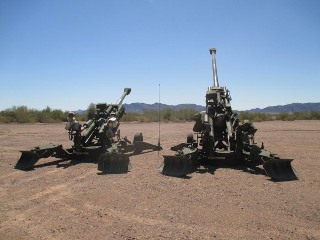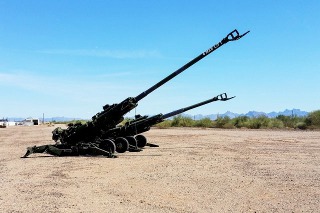 |
| October 02, 2018 | Volume 14 Issue 37 |
Designfax weekly eMagazine
Archives
Partners
Manufacturing Center
Product Spotlight
Modern Applications News
Metalworking Ideas For
Today's Job Shops
Tooling and Production
Strategies for large
metalworking plants
Army doubles M777 howitzer cannon range in prototype demo

The M777A2 and M777ER side by side at a test site. On Sept. 19, 2018, the Army fired a modified M777 howitzer, doubling its previous range. [Photo Credit: U.S. Army photo by PEO Ammunition]
By Nancy Jones-Bonbrest, Army Rapid Capabilities Office
The Army recently fired a modified M777 howitzer double its previous range, bringing the service one step closer to delivering the prototype Long Range Cannon capability.
[A normal M777 howitzer max range with unassisted rounds is 25 km (15.5 miles) and assisted 30 km (19 miles), with a goal for the latest updates to eventually reach 70 km (43.5 miles).]
The live fire demonstration, which took place at Yuma Proving Ground on Sept. 19, was a significant step in the Army's effort to rapidly prototype and equip select units with an interim Long Range Cannon solution. This increase in firepower, targeted for Army Infantry and Stryker Brigade Combat Teams and Marine Corps Expeditionary Formations, is a subset of the Army's top modernization priority of Long-Range Precision Fires.
"This demonstration highlighted how the Long Range Cannon system-of-systems can achieve ranges with the cannon, projectile, and propellant combinations that will help shape the battlefield for battalion and brigade commanders," said Col. Cobb Laslie, the U.S. Army Training and Doctrine Command capability manager for Brigade Combat Team Fires. "The partnership between the organizations that participated in the demonstration is focused on putting the best cannon with the most lethal projectiles into the hands of our Soldiers."
The Long Range Cannon's increased range, effectiveness, and accuracy of beyond-line-of-sight fires is in direct response to operational needs in the Pacific and Europe, and will deliver air mobile extended range capabilities to light and Stryker units. Complementary to the Extended Range Cannon Artillery, or ERCA, program for Armored Brigade Combat Teams, the Long Range Cannon is also leveraging other Army Long-Range Precision Fires prototyping and programmatic efforts, including existing and experimental munitions and future propellant upgrades.
The Long Range Cannon started as the Extended Range M777 project, a partnership between the Army's Program Executive Office Ammunition and the Marine Corps' PEO Land Systems. Managed by their Joint Program Office, Project Manager Towed Artillery Systems, the M777 Extended Range leverages technologies being developed by the Armaments Research, Development and Engineering Center for the ERCA program. In 2016, PM-TAS and ARDEC demonstrated the ability to integrate a longer tube into the M777 with minimal modifications to the system.
In early 2018, The Army Rapid Capabilities Office, or RCO, and PEO Ammunition partnered with the Army's Long-Range Precision Fires Cross-Functional Team and the Army and Marine centers of excellence for cannon artillery on the Long Range Cannon project to ensure programs can leverage lessons learned across their developmental paths.
In creating the prototype, the Army is combining an M777 Extended Range howitzer, a projectile tracking system radar, a surveying device, and a variety of advanced projectiles. The demo also showed what a new "supercharge" element could do to achieve double the range of current unguided High Explosive projectiles.

The M777A2 and M777ER side by side at a test site. [Photo Credit: U.S. Army photo by PEO Ammunition]
Together, these components are intended to serve as an interim solution to a critical capability gap, while also informing future Long-Range Precision Fires systems. The demo on Sept. 19 was a proof of concept using production-representative hardware, developmental propellant, and a projectile in order to demonstrate readiness for continued prototype development and production.
"This approach, of adapting existing systems and combining them with emerging technology to deliver a new capability, is a proven way to move faster and meet an urgent need now while the Army continues to work on a more permanent, long-term solution," said Mike Foster, Army RCO lead for the Long Range Cannon project. "This demo shows we are on track to provide integrated Long Range Cannon technologies to the units that need them."
Directed by the secretary and chief of staff of the Army through its board of directors, the RCO frequently partners with other organizations to deliver integrated prototypes to enable the Army to move faster than traditional acquisition systems have allowed in the past.
If successful, the Long Range Cannon would provide the Army with a mobile extended range capability that can be retrofitted into an existing howitzer system to provide new effects. This could provide an interim solution for select units of the Army's brigade combat teams with towed artillery, which deliver the external helicopter sling-load capability required for artillery raids and provide mobility to locations inaccessible by heavier systems. The technology could also be leveraged for a wheeled 155-mm howitzer. At the same time, the Long Range Cannon prototype will help bridge efforts, providing data and lessons learned that the Long-Range Precision Fires Cross-Functional Team can leverage to reduce risk and inform requirements before the ERCA and other enduring programs are fielded.
Following the demonstration, the Army plans to continue testing and development of the Long Range Cannon components, with the first operational assessment in fiscal year 2020. The demo also provided information to support improvements in training, maintenance, and operational procedures for the system.
Published October 2018
Rate this article
View our terms of use and privacy policy
